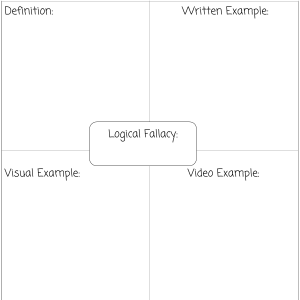Technology has transformed the way our learners share their opinions and argue. Not only do our learners observe arguments daily on their social networks, but they often participate. Our learners need to learn how to argue more intelligently, which is why in my book, Digital Learning Strategies: 10 Ways to Launch EdTech Missions, students are sent on the mission to engage in a thought-provoking online debate with their peers.
When our students want to state their opinions on their social networks, they have access to a worldwide audience. Additionally, most social networks focus on visuals and multimedia versus text. Many social networks limit the number of characters or promote less text. This means our learners have to share complex thinking and feelings about issues in short posts, usually 250 characters or less. Others respond and the debate ensues through comments or additional posts.
If you observe digital debates you will notice the broken logic. Arguments on social media are full of logical fallacies. Our learners need to be able to recognize the broken logic in their arguments in order to reflect on their beliefs and think critically about why they form opinions. The following are resources and activities I share with my students to get them to evaluate logical fallacies in order to complete the mission to Debate the Issues, Don’t Diss People. This would be a Mission Prep activity. After we evaluated some of the resources below, students created logical fallacies using Makebeliefs. See one example below.

Activities
- I created this Frayer Model (download the pdf) for students to explore the logical fallacies resources below. Students worked in small groups to become experts for their assigned logical fallacies and filled out the Frayer Model. Then the groups exchanged their expertise with the other groups who took notes. In each group one student read aloud the definition, another shared the written example, one introduced the visual, and one played the video. The final activity was to create a logical fallacies comic.

- Mark Allen shares his lesson plan for creating logical fallacy posters with students examples.
- Read Write Think has a lesson plan which gets students to spot the logical fallacies in advertisements.
- Clearer Thinking has many free mini-courses and quizzes to spot logical fallacies and bias.
- This lesson plan gets students to analyze Monty Python, “The Witch’s Trial” for logical fallacies.
Videos
- Check out this playlist of 6 critical thinking videos. Each is short and explains critical thinking and logical fallacies in an engaging way.
- This video uses clips from Subway commercials to demonstrate different logical fallacies.
- This video uses clips from the tv show, Friends, to demonstrate logical fallacies.
Visuals and Infographics
- Thou Shalt Not Commit Logical Fallacies is a website with several different fallacies visualized with cartoonish characters. Simple written examples are also provided.
- An Illustrated Book of Bad Arguments is a fun digital book with several humorous examples.
- Rhetological Fallacies is an infographic which divides fallacies to those that appeal to the mind, emotions, and other helpful categories.
- 30 of the Most Common Errors in Argumentation is another infographic which lists several logical fallacies.
Challenge– Encourage students to evaluate the common logical fallacies so that they make stronger arguments.
Get your copy of Hacking Digital Learning, The 30 Goals Challenge, or Learning to Go. Ask me about training your teachers, ShellyTerrell@gmail.com!
Subscribe for FREE to receive regular updates!







